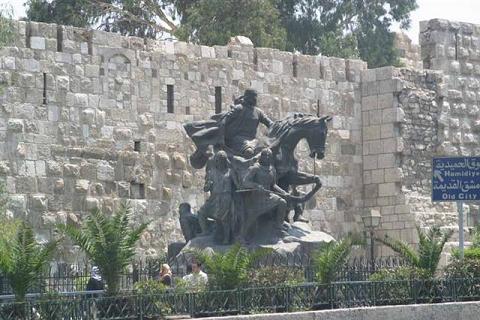 Damascus Citadel, better known as “Qalaat Dimashq”, is the only fortress in Damascus. It is located in the heart of the capital.
Damascus Citadel, better known as “Qalaat Dimashq”, is the only fortress in Damascus. It is located in the heart of the capital.
Historical records indicated that it was built by the Seljuks in 1078 A.D. with several gates. During the reign of Seljuks until 1104 and after, additional construction works were carried out in the citadel.
After attacks by the Crusaders and other invaders against the city of Damascus, some restorations were made in the citadel and more defenses were added to fortify the citadel against attacks.
Between 1203 and 1216, King al-Adel, brother of the Ayyubid Sultan Salahuddin, ordered Damascus Citadel to be demolished only to be rebuilt again. Sons of King al-Adel contributed to the rebuilding of the citadel’s towers and walls which took 15 years.
The castle was surrounded by a deep water trench. Each corner of the castle had a tower. There were two towers in the eastern side, one of which includes the eastern entrance to the castle, and three towers in the northern and southern fronts.
The towers are connected by thick walls, and behind the towers there is a roofed corridor around the castle securing the link between them and it is known as the defensive corridor.
During the eras of Nur addin Zanki and Salahdin al-Aaubi, the Citadel played a vital role in protecting Damascus from the threat of Crusaders, and supported the politics of the city.
Since it was built, the citadel was a very important military castle. It was the residence for the Ayyubid sultans, and a place where political and social events were held.
It was a city within a city. New parts were discovered during its restoration in 1985, so the citadel could be seen from all sides.
The citadel `was surrounded by palaces, baths, mosques, houses and schools.
In mid-thirteenth century, however, the citadel was the main target for Tatar and Mongol attacks which damaged it severely.
When the Mongols were driven out by the Mamluk Sultan of Egypt, Qutuz, in the battle of Ain Jalut in 1260, his successor Baibars rebuilt the citadel.
Between 1300 and 1401, Damascus Citadel was again under siege by Mongols, this time under Timor Lank. In 1405, the Mamluks ruled Damascus, and the citadel was rebuilt again. However, Damascus and the citadel were surrendered to the Ottomans in 1516.
During the 18th century Damascus Citadel was badly damaged by earthquakes, but was restored by the Ottoman Sultan Mustafa III.
Later, the citadel was used as military barracks and as prison under the French Colonization.
The present shape of the citadel is rectangular with 13 large towers and several dilapidated gates.
Damascus Citadel is really unique in Syria, as it was built on a flat ground at the same level of the rest of the city and not on a higher location.
One of the most important monuments in the citadel is the mosque of Abi al-Dardaa, one of Prophet Mohammad’s (PBUH) companions whose tomb is still being visited.
Damascus citadel is considered as a symbol of old and modern civilization in Damascus, the most ancient continuously inhabited city in the world.
Raghda Sawas

